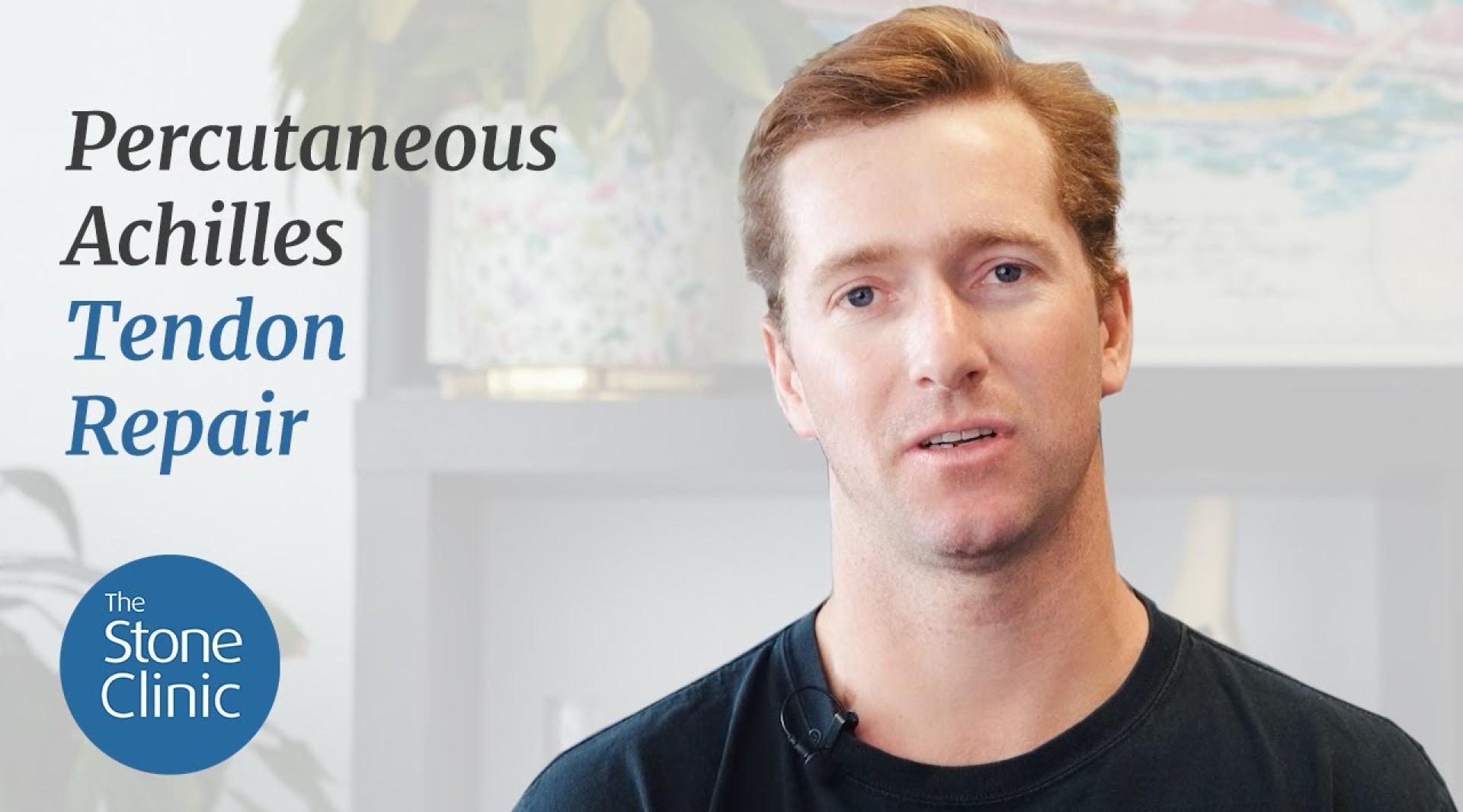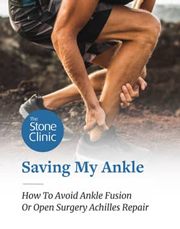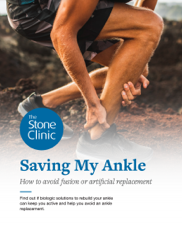Surfers Returns from Ruptured Achilles with Percutaneous Repair
So my name's Harper. I tore my Achilles full rupture in early January of 2022 while playing pickleball. Actually, I'm not the type of athlete that can kind of go half-speed. So, you know, we were just warming up and didn't have any crazy movement or anything like that, and just felt a, a pop. And it really felt like almost like an air bubble in my shoe popping and almost felt like I lowered into my heel two days of heavy activity between hiking and surfing, followed with the pickleball match. I imagine overuse and dehydration probably had something to do with it. But wasn't a very sporty move or anything just kind of bad luck. I suppose I originally did schedule the open surgery. Met a doctor down in Palo Alto after two doctors here in San Francisco and had done a little bit of research about the percutaneous method, but all three of those doctors didn't see that as an option that the tear was bad enough and the gap was big enough such that, you know, they kind of were pretty dismissive of that idea of less invasive surgery.
So I scheduled the open surgery with the idea that I wanted as little amount of time between the injury and surgery. And then, yeah, we all got C so surgery was canceled delayed two weeks with a bunch of COVID testing in between tested negative and came in right away to the stone clinic after just, you know, looking at YouTube videos and a friend had, had had a knee repair here. He has torn both knees one. He got a more traditional repair and one with Dr. Stone. And he just raved about Dr. Stone and the team here and kind of the, you know, the fact that you're coming in, you're getting your MRI here. Your surgeon is here, your physical therapy is here. So having all that under one roof I think is pretty special. And for me being an athlete through college and a team guy used to working with trainers, I think there is really this team mentality.
When you come into The Stone Clinic, that's pretty unique. The other surgeons that I met with that were gonna be basically, you know, one meeting prior to the surgery, and then they'd send me off to a third party for physical therapy. So we scheduled the surgery for three days later. He had an opening and I got surgery on a Tuesday and then was in here on Wednesday doing crunches and pushups and working with the team. I think they recognized in me that you know, competitive and wanted to heal as quickly as possible. And I'm used to surfing, you know, a hundred-plus days a year. So missing out on all that surfing, I had to put my mind and focus on something else. And so being able to come in here two to four times a week was pretty special.
And yeah, as far as the program started out with you know, just strength and conditioning, other parts of the body, mainly core and then after, you know, three, four weeks started to do light work around the Achilles. A lot of it was massage and just working on the scar tissue. And then that ramped up month to month you know, started to focus more specifically on the Achilles and calve and bringing some of that strength back probably like month, 2, 3, 4, and five, and then just have my six-month checkup on Monday, got cleared to surf and surf the following day. So you know, I, I still have room to recover. It's a long road for an Achilles surgery, but the fact that I'm back doing my hobby inside of you know, a week inside of the six-month mark is you know, couldn't have asked for a better outcome.
It was great to be out there. I, you know, caught three waves felt really good, Achilles feel, super strong. Definitely still work to do as far as getting back to playing basketball and things like that. But I mean, it's, I, I really couldn't ask for faster progress or a better outcome at this stage. I, I mentioned, you know, being an athlete and a competitive person, so I've been able to golf and surf inside of six months since the surgery and yeah, just coming back to that mental piece the support of the team here with the focus on getting returning to competitive sports as quickly as possible is something that the team recognized. They adjusted my training that way, Dr. Stone recognized that. And so it's all kind of culminated into, you know, getting back to athletics and kind of real life.
The other thing I should mention is that when I tore my Achilles, I had twins that were a year and a half old. So my wife took on a ton of work in terms of just wrestling around with these guys. And yeah, that was, you know, probably the biggest motivation even more so than surfing was just being able to pick up my kids, play with my kids. And I was walking around carrying them. They're pretty big guys you know, three months post-surgery I was kind of back to full-time dad duty. And yeah, couldn't ask for, you know, a better outcome in terms of the speed with which I was able to recover. And then, yeah, just continuing on with the physical therapy program today, doing more stuff at home, the team's kind of giving me exercises and things like that when I can't get in the office here.
And so yeah, they really try and look at you as an individual, your specific injury, what are your goals? What are your timeline goals? And then build a program around that. I just think that the fact that the surgeon is here as well as the PT team is something that really sets apart stone aside from just the percutaneous method in general and all the other doc doctors kind of dismissing that option. You know, again, that everything's under one roof is pretty unique, other than surfing, just wanna get back to, you know, hopefully, get a couple more lacrosse games in before I fully retire. I'm turning 35 in November and still play lacrosse for the Olympic club. So I think I'm, I'm on the waning days of running my head into other people, but big Achilles feels good enough where I feel like I can put on the pads and get another couple games in before fully hanging it up prior to surgery.
And then the first month after surgery was just so hard, you know, I'm laid up in bed and my twins are wrestling over me and I can't really do much. So being back to just running around with them has been a dream. I think the, the main two things are one, you know, find a way to maintain your mental health and be strong. And number two be an advocate for yourself when you're kind of finding the right surgeon or the right approach to your recovery. All the doctors told me that percutaneous was not an option and within, you know, five or 10 minutes, the Dr. Stone seeing my MRI he said, we can definitely do it this way. And that's what we're recommending, you know, huge thanks to the stone clinic. Like I said, mark and the front office getting the MRI, Dr. Stone doing the surgery and kind of coming up with the game plan and then Shannon and Allison in the physical therapy office, just can't say enough about the people here, everyone from the front desk, all the way to, you know, the folks that are kind of working around the office to keep things clean at their smiley faces. They really give you that team mentality of you know, this is gonna be hard, but it's supposed to be hard. Probably won't put this in the video, but I'd come in and they'd have these nice quotes up. They would say like, you know, work hard today and I'd go and erase it and write the cure for pain is pain. And then I'd get to my physical therapy. So <laugh> the pain actually, wasn't really all that bad at all. But just, you know, as a fun group of people they made, what was a devastating injury and a pretty tough time in my life, better by refocusing my energy instead of, you know, being stuck on the injury, feeling bad for myself, it was, you know, get a six pack, do push up.
So they really do push you. And I think that's why I was able to get back in the water surfing inside of six months, playing golf with inside of six months, and am well on my way to being back to full strength. So yeah, just, you know, if you have one of these injuries, stick with it talk to Dr. Stone and his team, and hopefully you'll feel the same thing I felt, which is, you know, you're gonna become part of this team in this recovery process. And yeah, can't say enough good things about the office here and the whole team, very grateful to Dr. Stone and this group thanks so much.
Dr. Stone:
Harper's a classic example of a highly athletic young father with kids. One day is out hiking and the next day suddenly does a sudden motion feels a pop, hurt, a shot, and is ruptured as Achilles tendon. He presented to us with a dramatic rupture where the tear extended, not just in the Achilles, but up into the muscle. And there was an appearance of degeneration of at tendon throughout. So most of those type of ruptures and MRI appearance have traditionally been repaired with an open surgery, a large incision and a very long rehabilitation program and a risk of infection. We've found that we can percutaneously repair them as we did for Harper, where we weave sutures through little small skin Nicks underneath the skin and can pull the ligament together, can augment it with a growth factor injection once or twice, and then get them back by rehabbing them quite aggressively early on. So here he is at six months cleared to return to surfing with a thick well heeled Achilles tendon without an open incision.
Harper C. Profile
At our Clinic, we have optimized a technique that allows us to avoid making an open incision when performing an Achilles surgical repair. This approach allows us to preserve the growth factors that speed healing and decrease infection. Our technique is called Percutaneous Achilles Repair and works by passing sutures through the skin and pulling the ruptured ends of the tendon together, allowing the tendon to heal back to its normal strength without "open surgery."
This surgical repair plus post-op injections of growth factors and an immediate rehabilitation and strengthening program helped Harper safely return to sports and the all-important job of being a new parent of twins.



